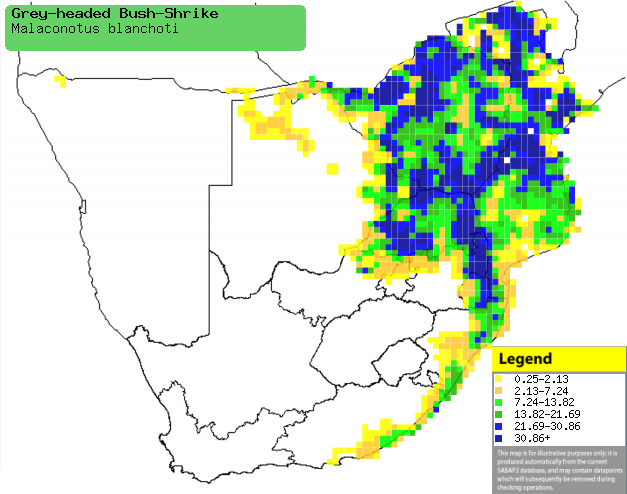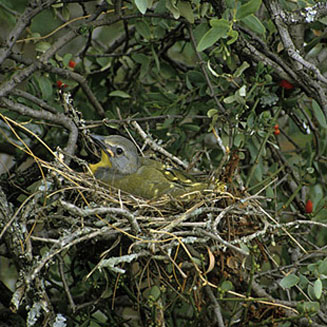|
Malaconotus blanchoti
(Grey-headed bush-shrike)
Spookvoël [Afrikaans]; Umbhankro [Xhosa]; uHlaza (also
applied to Orange-breasted bush-shrike) [Zulu]; Spookklauwier [Dutch];
Gladiateur de Blanchot [French]; Graukopfwürger, Riesenbuschwürger [German];
Picanço-de-cabeça-cinzenta [Portuguese]
Life
> Eukaryotes >
Opisthokonta
> Metazoa (animals) >
Bilateria >
Deuterostomia > Chordata >
Craniata > Vertebrata (vertebrates) > Gnathostomata (jawed
vertebrates) > Teleostomi (teleost fish) > Osteichthyes (bony fish) > Class:
Sarcopterygii (lobe-finned
fish) > Stegocephalia (terrestrial
vertebrates) > Tetrapoda
(four-legged vertebrates) > Reptiliomorpha > Amniota >
Reptilia (reptiles) >
Romeriida > Diapsida > Archosauromorpha > Archosauria >
Dinosauria
(dinosaurs) > Saurischia > Theropoda (bipedal predatory dinosaurs) >
Coelurosauria > Maniraptora > Aves
(birds) >
Order: Passeriformes
> Family: Malaconotidae
Distribution and habitat
Occurs in a band from Senegal to Ethiopia, extending south
to large areas of south-central and southern Africa, largely absent from the
lowland forests of the DRC and West African coast. It is uncommon in southern
Africa, with populations across Zimbabwe, Mozambique, Limpopo Province,
KwaZulu-Natal (marginally into the Eastern Cape) and small areas of Botswana. It
generally occupies wooded areas, especially Miombo, Acacia and riverine
woodland, but it occasionally moves into suburban gardens and alien tree
plantations adjacent to indigenous forest.
|
 |
|
Distribution of Grey-headed bush-shrike in southern Africa,
based on statistical smoothing of the records from first SA Bird Atlas
Project (©
Animal Demography unit, University of
Cape Town; smoothing by Birgit Erni and Francesca Little). Colours range
from dark blue (most common) through to yellow (least common).
See here for the latest distribution
from the SABAP2. |
Food
An adaptable hunter, it will eat almost any animal that it
can catch and kill, ranging from small insects to large 1 metre long snakes and
other bird chicks. It often gleans prey from leaves and branches, either eating
them immediately or impaling them on a thorn to be eaten later. Prey items which
are to large to be swallowed are ripped into bite-sized pieces. The following
food items have been recorded in its diet:
- Invertebrates
- Vertebrates
Breeding
- Both sexes construct the nest, the male collecting material and giving it
to his partner, who incorporates it into the structure. This consists of a
flimsy shallow cup made of leaves, grass stems and twigs, lined with
rootlets and other soft plant matter. It is usually placed in a deciduous
tree branch fork, about 3-6 metres above ground. It may also use abandoned
nests of doves,
turacos and
goshawks.
 |
|
|
Grey-headed bush-shrike female at its nest,
Nylsvley area, South Africa. [photo Warwick Tarboton ©] |
|
- Egg-laying season is from about August-January, peaking from
September-November.
- It lays 2-4 eggs which are incubated solely by the female, while the
male brings her food.
- The chicks are brooded during the night and early afternoon by one their
parents (usually the female, but the roles are sometimes reversed); the male
does all of the hunting. The chicks stay in the nest for about 20-24 days,
after which they remain in their parent's territory for up to a year.
Threats
Not threatened.
References
-
Hockey PAR, Dean WRJ and Ryan PG 2005. Roberts
- Birds of southern Africa, VIIth ed. The Trustees of the John Voelcker
Bird Book Fund, Cape Town.
|
